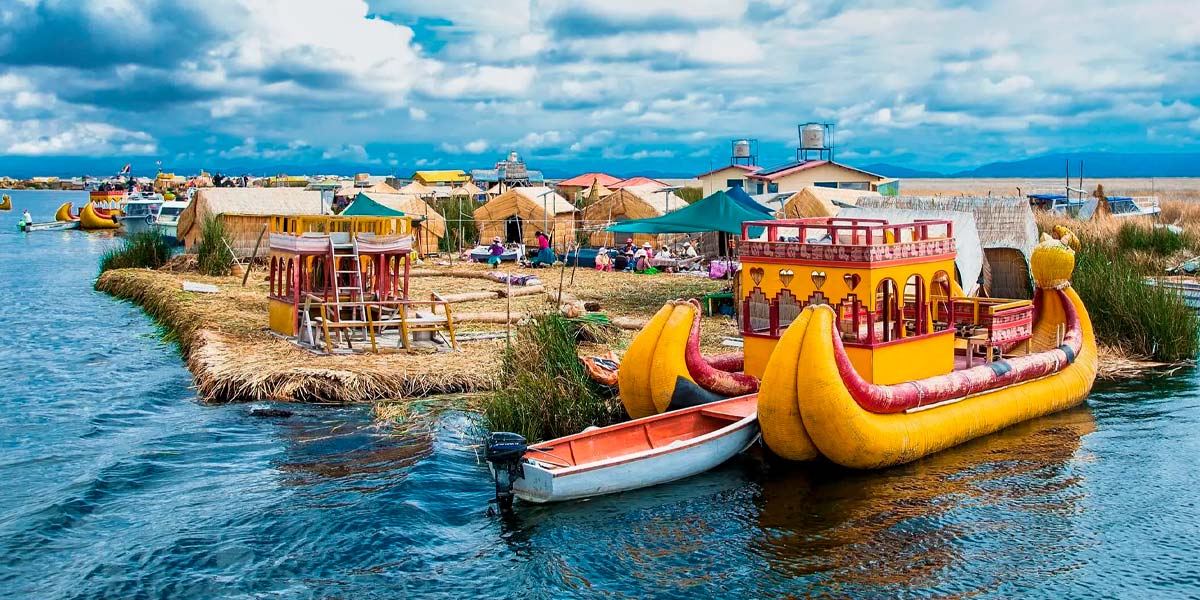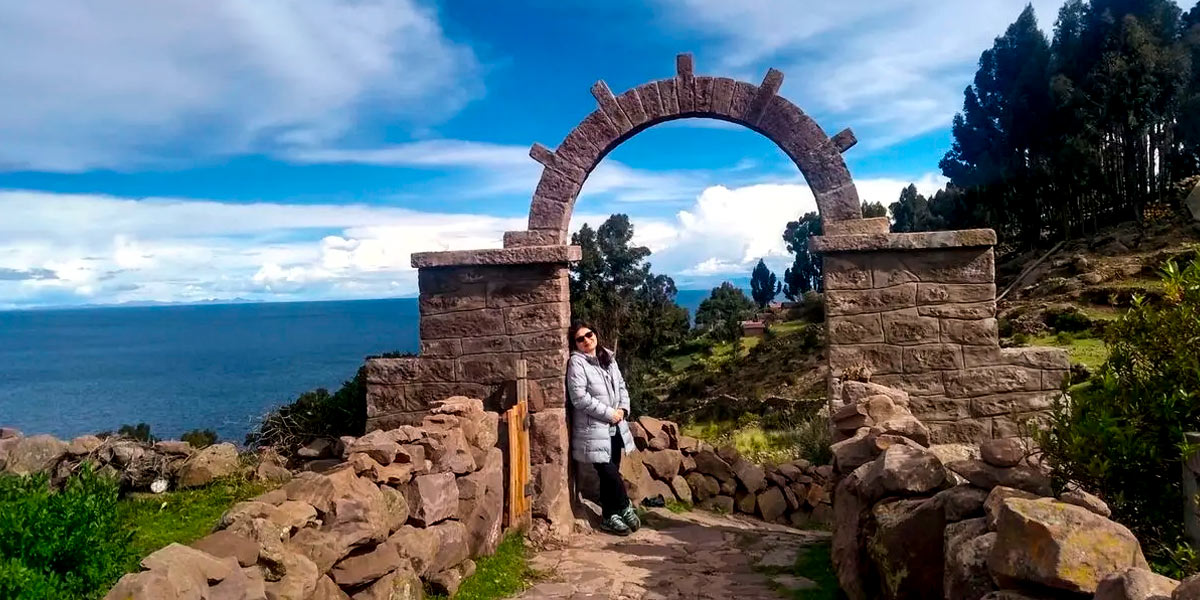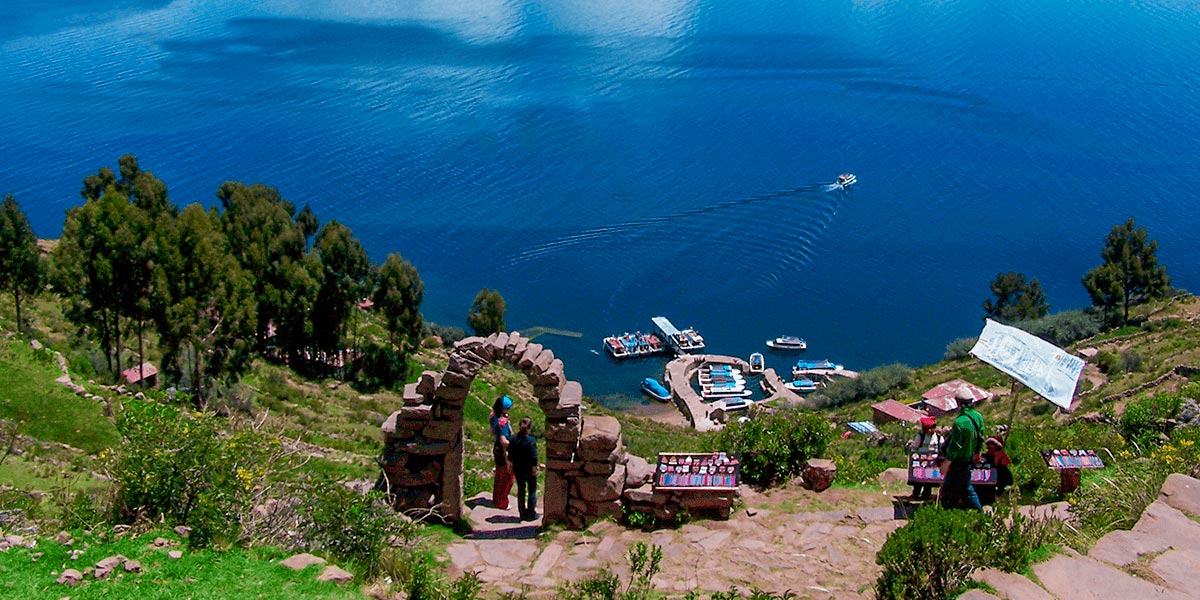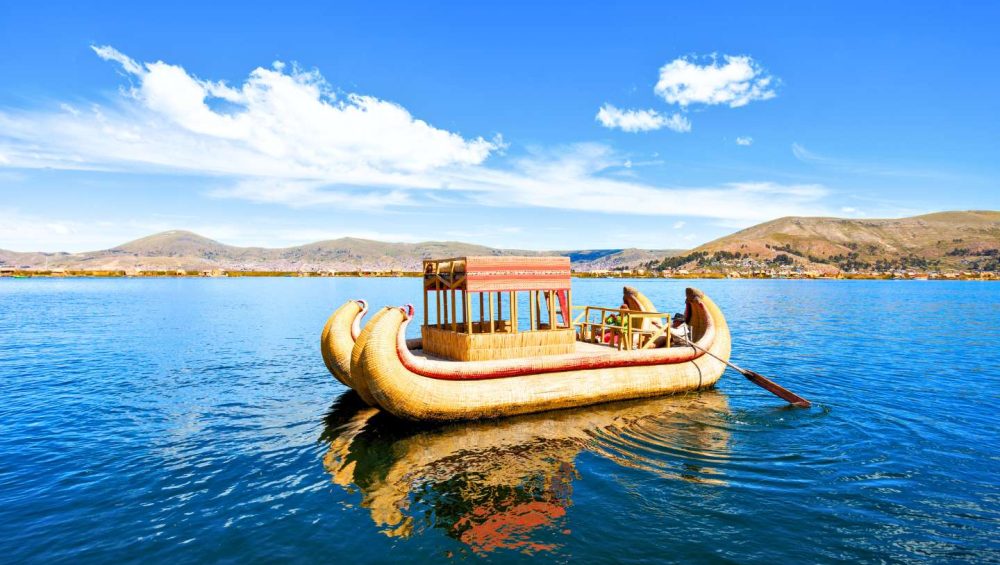Millions of years ago, movements in the Earth’s crust caused rocky layers to sink, creating a large basin that was later filled with water from melting ancient glaciers and rainfall. This is how Lake Titicaca emerged, whose initial level was between 60 and 100 meters above the current one.
In Inca tradition, this lake has deep symbolic value, as it is considered the place where creation began. According to legends, the god Viracocha emerged from its waters to give rise to the sun, the stars, and the first Inca rulers, which makes the lake a sacred setting charged with historical and cultural meaning.
Situated at about 3,800 m.a.s.l., Lake Titicaca Peru holds the title of the highest navigable lake on the planet. Its waters remain serene and cold throughout the year, with an average temperature of approximately 13 °C. During winter, the waters usually reach 11 °C, while in the summer months they can rise to close to 15 °C. The coldest days usually occur in July, while the warmest period occurs between December and March.
Location
Lake Titicaca is located on the altiplano of the Central Andes, on the border between Peru and Bolivia. Its surface extends for nearly 8,500 square kilometers and reaches depths of up to 280 meters. In addition, it ranks as the second largest lake in South America, after Lake Maracaibo, standing out for its geographical relevance and for being home to numerous inhabited islands that preserve ancestral traditions.
About the Flora and Fauna in the Lake
- Lake Titicaca is a true wildlife sanctuary. More than 350 species of aquatic birds have been recorded in its surroundings, including ducks, coots, and Andean flamingos.
- Its waters are home to characteristic fish such as the suche, trout, and carachi, which are important for both the ecosystem and the diet of local communities. Among amphibians, the giant frog and the Titicaca grebe stand out, unique species that have adapted to the extreme conditions of altitude and cold.
- Regarding flora, the lake has about 12 types of aquatic plants, with totora being the most representative. This plant is essential for the inhabitants of the region, as it is used to make boats, floating homes, handicrafts, and even as animal feed.
- Various mammals, such as foxes and guinea pigs, live in the lands surrounding the lake and are part of the terrestrial fauna of the place. It should be noted that almost 90% of the fish in the Titicaca basin are endemic, meaning they are exclusive to these waters.
What to See and Do in Lake Titicaca
There are plenty of reasons to include Lake Titicaca in any itinerary. Sailing its waters is an unforgettable experience, as it allows you to contemplate landscapes of unique beauty and get closer to the way of life of the local communities. Among the most recommended activities is visiting the Uros floating islands, built entirely with totora, where the inhabitants show their traditions and way of life. In addition to excursions, travelers can enjoy rides on traditional rafts, observe birds, taste typical cuisine based on fresh fish, and visit pre-Hispanic temples that reveal the historical and cultural importance of this region. Every corner of Lake Titicaca offers unique experiences, full of history, nature, and culture.
Floating Islands of the Uros
One of the most representative places on Lake Titicaca are the Floating Islands of the Uros. The Uros, considered one of the oldest cultures on the continent, maintain that their history dates back to times before the Inca empire. They describe themselves as “men of the water” and live mainly from fishing, hunting, and making textile products with alpaca wool. Today, many Uros families find tourism a key source of income, showing travelers their way of life and traditions.
The most fascinating thing about these islands is the way they are built. In the shallower parts of the lake grows totora, an aquatic plant that is collected and woven together to form the surface of the islands. These platforms need continuous maintenance, as the water deteriorates the lower layers, which requires regularly renewing the upper layers to prevent the islands from sinking.

Taquile Island
Taquile is a small island, with about 2,200 inhabitants, famous for the beauty of its landscapes and the serenity of its surroundings. Its highest point is at 4,050 m.a.s.l., from where you get a magnificent view of the snow-capped Cordillera Real, which extends into Bolivian territory, on the other side of the lake.
The hills of Taquile are covered with agricultural terraces of Inca origin and archaeological remains that tell the story of a great era. Its inhabitants, proud of their roots, have kept their cultural identity alive through generations. In addition, their handmade textiles are recognized by UNESCO as Intangible Cultural Heritage of Humanity, thanks to the extraordinary quality and symbolism of their designs. Visiting Taquile is exploring a place where traditions remain strong and are part of daily life.

Amantaní Island
Close to Taquile is Amantaní, another island included in the route of many travelers. Although it receives many visitors, its natural environment remains serene and full of charm. Among the best activities on the island is the ascent to the elevations where the temples of Pachamama and Pachatata are found, pre-Hispanic constructions that are in excellent condition and offer amazing panoramic views of the lake and the altiplano.
Amantaní is also recognized for providing travelers with an authentic cultural experience. There, it is possible to stay in local family homes, who share their customs, gastronomy and traditions. During the stay, visitors can participate in textile work, as well as in agricultural and livestock tasks, enjoying a coexistence that leaves indelible marks.

How to get to Puno?
To explore Lake Titicaca, you first need to get to the city of Puno, located in the Peruvian altiplano. There are several ways to travel there from Lima, each with its own characteristics in terms of comfort, time, and budget.
- By air
You can take a flight from Lima at Jorge Chávez Airport to the city of Juliaca, where you will land at Inca Manco Cápac Airport. The flight takes approximately 1 hour and 30 minutes. From Juliaca, you will need to continue by road to Puno, either by taxi or bus. This additional leg usually takes about an hour, depending on traffic and weather conditions. Please note that, currently, there are no direct flights between Lima and Puno, so Juliaca is the closest air route. - By land in bus
Another option is to travel by bus from Lima to Puno. Several transport companies offer this service, and buses depart from the main terminals in the capital. The journey takes, on average, about 20 hours. This alternative is usually more economical, although it can be demanding due to the long time on the road and the altitude reached in some sections of the trip. It is advisable to choose companies known for their safety and comfort for long journeys. - By train
If you are in Cusco, you have the possibility of traveling to Puno on the PeruRail Titicaca train, a service that stands out for the beauty of its landscapes along the route. The journey takes approximately 10 hours and 30 minutes and crosses valleys, mountains, and Andean plains, allowing you to enjoy unique views as you travel to Puno. This train journey is considered one of the most attractive railway routes in South America and usually includes onboard services, such as lunch and cultural entertainment.
Best time to visit Lake Titicaca
The most advisable season to travel to Lake Titicaca extends from May to September. During these months, the climate has less rain, clear skies, and daytime temperatures that usually range between 15 °C and 20 °C. At night, the cold can intensify, so it is essential to have warm clothes. This time of year, known as the dry season, is ideal for visiting emblematic places such as the floating islands of the Uros, Taquile, and Amantaní, as the weather conditions allow navigation and exploration without major setbacks.
Tips for visitors
To fully enjoy your stay at Lake Titicaca and avoid inconveniences related to altitude, keep the following recommendations in mind:
- Stay a few days in places located at a lower altitude before heading to the lake. This helps your body adapt and reduces the risk of suffering from soroche, or altitude sickness.
- Pack appropriate warm clothing, especially for cold nights.
- Include a poncho, raincoat, or windbreaker jacket in your luggage to protect yourself from wind gusts or occasional rains.
- Wear gloves, a hat, and a scarf, as they may be necessary at certain times of the day.
- Choose comfortable and resistant footwear, such as sports shoes or trekking boots, that allow you to walk on uneven terrain.
- Drink enough water throughout the day to stay hydrated.
- Limit alcohol consumption and avoid smoking during your stay, as they can worsen the symptoms of altitude sickness.
- Opt for light meals, but with a good caloric intake to maintain your energy.
- Consuming coca tea or chewing its leaves can be useful to prevent or relieve symptoms associated with altitude.
- When hiking, maintain a slow and unhurried pace to avoid exhaustion.

